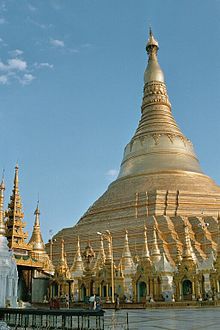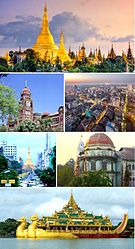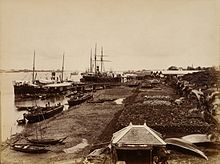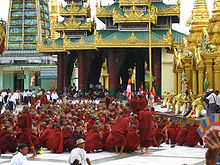Rangoon
| ရန်ကုန် Rangoon |
||
|---|---|---|
|
|
||
| Coordinates | 16 ° 47 ' N , 96 ° 9' E | |
| Basic data | ||
| Country | Myanmar | |
| Yangon region | ||
| ISO 3166-2 | MM-06 | |
| height | 15 m | |
| area | 576 km² | |
| Residents | 5,209,541 (2013) | |
| density | 9,044.3 Ew. / km² | |
| Post Code | 11181 | |
| Website | www.yangoncity.com.mm | |
| politics | ||
| mayor | Aung Thein Lynn | |
| miscellaneous | ||
| City structure | 4 districts, 32 districts | |
Rangoon (officially Yangon [ jaŋˈgʊn ], English Rangoon ) is a city in Myanmar and the capital of the Yangon Division . With around 5.21 million inhabitants in the actual city and 5,998,000 inhabitants in the agglomeration (2013 census), Yangon is the largest city and the industrial center of the country. Up until 2005, Rangoon was the capital of Myanmar; the seat of government was then moved to Naypyidaw .
geography
Geographical location
Rangoon is located in the south of the country on the eastern edge of the Irrawaddy Delta near the Gulf of Martaban, an inlet of the Andaman Sea , an average of 15 meters above sea level .
City structure
Yangon is divided into four districts and 32 districts:
- Western District (inner city): Ahlone Township, Bahan Township, Dagon Township, Kyauktada Township, Kyeemyintdine Township, Lanmadaw Township, Latha Township, Pabedan Township, Sanchaung Township and Seikkan Township
- Eastern District: Dagon Seikkan Township, East Dagon Township, North Dagon Township, North Okkalapa Township, South Dagon Township, South Okkalapa Township, Thingangyun Township, and Botahtaung Township
- Northern District: Hlaing Township, Hlaingthaya Township, Insein Township, Kamayut Township, Mayangone Township, Mingaladone Township, Pazundaung Township, and Shwepyitha Township
- Southern District: Dala Township, Dawbon Township, Mingalataungnyunt Township, Thaketa Township, Tamwe Township, Yankin Township and Seikkyi Kanaungto Township
climate
The city is located in the tropical climate zone . The average annual temperature is 27.5 degrees Celsius and the average annual rainfall is 2681 millimeters.
The average temperature throughout the year is 25.0 to 30.3 degrees Celsius. The warmest month is April with an average of 30.3 degrees Celsius, the coldest is January with an average of 25.0 degrees Celsius.
The main rainy season is between May and October. Most of the precipitation falls in August with 602.0 millimeters, the least in February with 2.0 millimeters.
| Rangoon | ||||||||||||||||||||||||||||||||||||||||||||||||
|---|---|---|---|---|---|---|---|---|---|---|---|---|---|---|---|---|---|---|---|---|---|---|---|---|---|---|---|---|---|---|---|---|---|---|---|---|---|---|---|---|---|---|---|---|---|---|---|---|
| Climate diagram | ||||||||||||||||||||||||||||||||||||||||||||||||
| ||||||||||||||||||||||||||||||||||||||||||||||||
|
Long-term mean temperature and precipitation (1961–1990)
|
|||||||||||||||||||||||||||||||||||||||||||||||||||||||||||||||||||||||||||||||||||||||||||||||||||||||||||||||||||||||||||||||||||||||||||||||||||||||||||||||||||||||||||||||||||||||||||||||||||
history
Historical overview
Until 1755 the city was called Dagon and belonged to the Mon kingdom . Its origins go back to the 5th century BC. BC back. After the subjugation of all cities of the Mon by the Burmese king Alaungphaya , the latter raised the city to the capital of the Burmese Empire in 1755. He renamed it Yangon , which translated means "end of the dispute".
In 1824 , Rangoon was conquered by Great Britain , which relinquished its claim to rule two years later. The city developed into a modern parish from the end of the 19th century after it came under British rule again in 1852 after the Second Anglo-Burmese War.
In 1930, Rangoon was largely destroyed by an earthquake and the subsequent tidal wave . During the Second World War , the city was occupied by the Japanese army on March 8, 1942, during the Pacific War . When Burma gained independence from Great Britain in 1948, Rangoon became the country's capital.
From 1954 to 1956 the sixth Buddhist council of the Theravada tradition took place in Rangoon .
On October 9, 1983, 19 people, including four cabinet members from South Korea , died in a bomb attack in northern Rangoon . The dead were Kim Jae Ik, Suh Sook Joon, Hahn Pyong Choon and Foreign Minister Lee Bum Suk. Following investigations, North Korea was officially accused of perpetrating the attack.
On August 8, 1988, months of unrest ( 8888 uprising ) over the economic policy of the military under the leadership of General Ne Win culminated in the violent suppression of protests in Rangoon, killing several thousand. A new military regime under General Saw Maung established itself as the State Council for the Restoration of Law and Order (SLORC).
In 1989 the English colonial name Rangoon (Rangoon) was changed back to Yangon .
When the opposition National League for Democracy (NLD) won a landslide in democratic elections in 1990 , the elections were declared invalid by the military regime, and peaceful student protests were brutally suppressed in Rangoon. The regime stayed in power.
On November 7, 2005, Information Minister General Kyaw Hsan announced that the day before work had begun on moving all ministries and other government agencies from Rangoon to Naypyidaw . This made Naypyidaw the new seat of government and the country's official capital from December 2005.
In August 2007 protest rallies formed in Rangoon , initially led by Buddhist monks and nuns , which were soon joined by civilians. On September 24th, over 100,000 demonstrators were counted. Unlike in the past, the military leadership initially did not intervene, but on September 25 they began to crack down on the demonstrators. According to official figures, ten people were killed, including a Japanese journalist. Unofficial observers spoke of up to 200 dead. Several hundred people were injured. Soldiers stormed numerous monasteries in Rangoon. Opposition politicians have also been arrested across the country. In total, there are said to have been hundreds of arrests. Four days later, the military junta finally declared the revolt broken and over.
Population development
The following overview shows the population figures according to the respective territorial status. A population of 8.4 million is forecast for the year 2050.
|
|
religion
Rangoon is the seat of a Roman Catholic archbishop .
Culture and sights

Buildings
The city is home to the National Museum of Art and Archeology, the National Library and the World Peace Pagoda , which was built in 1952 in honor of the 2500th anniversary of the Buddha's death .
Pagodas
Three large pagodas are particularly noteworthy: the Botahtaung Pagoda near the port , the Sule Pagoda , which is the urban planning reference point of the colonial city center, and the Shwedagon Pagoda, the religious center of Myanmar.
The 40 meter high Sule Pagoda, which is also called Kyaik Athok , is said to have been built since 253 BC. Exist when the monks Sona and Uttara brought, among other things, ten hairs of Buddhas from the third Buddhist council .
Probably the most notable monument in the city is the great Shwedagon Pagoda, an old Buddhist shrine 98 meters high and covered with gold leaf. According to tradition, the oldest parts of the pagoda date from the 5th century BC. Since 1564 the pagoda has been repeatedly damaged by eight earthquakes. During a quake in 1786, the entire upper part crashed. The current height and shape go back to the renovations that followed. A fire last caused severe damage in 1931.
Colonial architecture
Rangoon is one of the few cities in Southeast Asia that has retained a relatively large number of buildings from the colonial era to this day. These include former government and administrative buildings, residential and commercial buildings, but also numerous places of worship of various religions, a result of the great immigration flows under British rule, especially from India. Today, in the old town, which was planned by the British in the 19th century, there are Buddhist pagodas as well as several Hindu and Chinese temples, numerous mosques and some churches. Smaller religious communities such as the Jainas also have their own buildings in the old town of Rangoon that date from the British colonial era. This also includes a small synagogue (on 26th Street). The call to prayer from muezzins is just as much a part of everyday life in the old town of Rangoon as Buddhist monks accepting food, Hindu processions and church bells.
The old building stock is, however, strongly threatened, on the one hand by the decades of neglect of the buildings, on the other hand by real estate speculation: the political and economic reforms under President Thein Sein since 2011 have significantly increased economic dynamism in Myanmar and real estate prices in Rangoon have risen. Conservationists therefore fear that a similar development is imminent in Rangoon as in other metropolises in Asia, in which the architectural heritage has fallen victim to property speculation.
Economy and Infrastructure
economy
Yangon is Myanmar's most important seaport . Most of the industry is located around the city. The main products are food, pharmaceutical articles, fabrics and textiles. Tourism in particular, but also shipbuilding and the ship repair industry and oil refineries , are of great importance to the economy.
traffic
Since December 2010, Yangon has been directly connected to Mandalay via the Yangon-Mandalay Expressway .
From January to June 2016, the Yangon tram operated 4.8 kilometers in length with second-hand trams from Hiroshima on a newly built route in the south of the city center.
Air traffic
Yangon has an international airport . The Yangon International Airport ( IATA code RGN) is located approximately 19 km north of the city center in the suburb Mingaladon. Since the airport only met international standards to a limited extent, extensive work began in 2003 to expand the airport and its infrastructure. This includes the extension of the only runway to date and a spacious new terminal building. When the measure is completed in 2006, Yangon International can also be served by wide-body jets such as the Boeing 747 and will have an estimated capacity of around 2.7 million passengers per year.
education
There are numerous universities, colleges and research institutes in Rangoon. These include: East Yangon University, Thingangyun Education College, West Yangon University, Yangon Institute of Economics, Yangon Institute of Education, Yangon Institute of Marine Technology, Yangon Institute of Nursing, Yangon Technological University, Yangon University, Yangon University of Dental Medicine , Yangon University of Computer Studies (UCSY), Yangon University of Culture, Yangon University of Distant Education, Yangon University of Foreign Languages, Yangon University of Medicine 1, Yangon University Of Medicine 2, Yangon University of Para-Medical Science, Yangon University of Pharmacy and Yankin Education College.
Twin cities
sons and daughters of the town
- Abraham Sofaer (1896–1988), British actor
- Peter Townsend (1914–1995), British colonel-pilot and writer
- Henry Kamen (* 1936), historian
- Aung San Suu Kyi (* 1945), politician and independence fighter
- Nick Drake (1948–1974), British folk musician
- James Wilby (born 1958), British actor
- Thiha Sithu (* 1987), football player
- Kyaw Zin Htet (* 1990), soccer player
- Win Morisaki (* 1990), actor and singer
- Kaung Sett Naing (* 1993), football player
- Min Kyaw Khant (born 1995), football player
- Maung Maung Lwin (* 1995), soccer player
- Hein Thiha Zaw (* 1995), soccer player
- Ye Min Thu (* 1998), soccer player
Web links
Individual evidence
- ↑ United Nations World Urbanization Prospects, 2007 revision World Urbanization Prospects: The 2007 Revision Population Database ( Memento of December 23, 2009 in the Internet Archive ), December 23, 2009
- ↑ Der Standard : Wednesday: Dead in protests in Rangoon , September 28, 2007
- ↑ Tagesschau : “We march for the people” (tagesschau.de archive), September 24, 2007
- ^ Münchner Merkur, October 1st, 2007
- ↑ Der Spiegel: Japanese broadcaster speaks of execution , September 28, 2007
- ↑ Tagesschau: Storming monasteries in the capital, Rangoon (tagesschau.de archive), September 27, 2007
- ^ Süddeutsche.de: Nine dead, several monasteries stormed , September 27, 2007
- ↑ City population 2050 | Sustainability Today. Retrieved July 24, 2018 .
- ^ The Independent: Colonial past could be the saving of Rangoon , Feb. 20, 2011
- ↑ The Straits Times: Saving Old Yangon ( Memento from February 21, 2013 in the web archive archive.today ), May 24, 2012:









